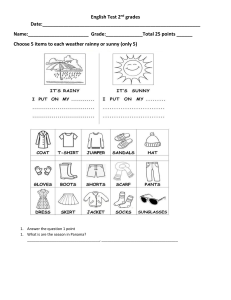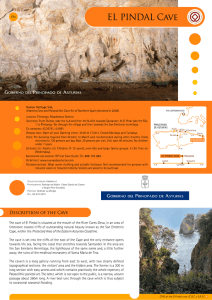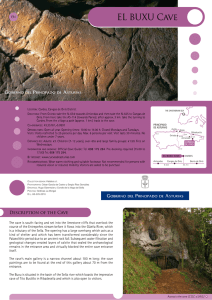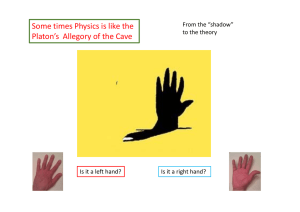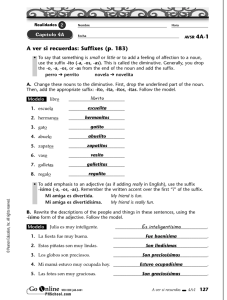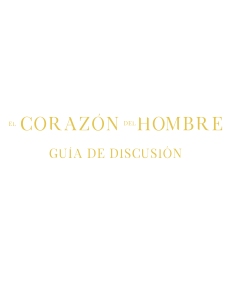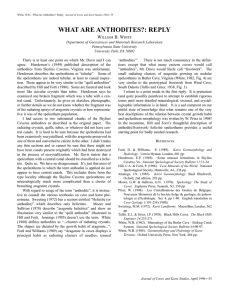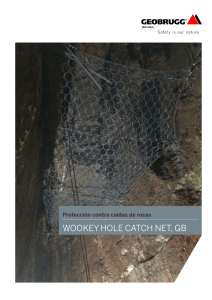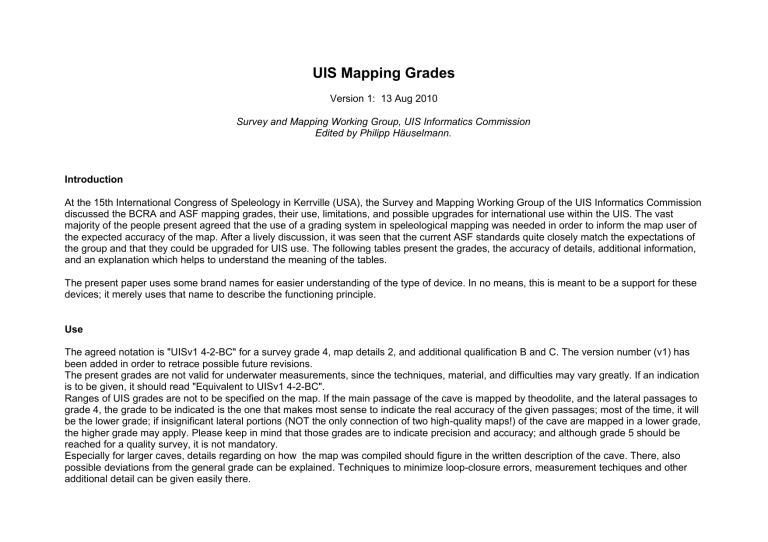
UIS Mapping Grades Version 1: 13 Aug 2010 Survey and Mapping Working Group, UIS Informatics Commission Edited by Philipp Häuselmann. Introduction At the 15th International Congress of Speleology in Kerrville (USA), the Survey and Mapping Working Group of the UIS Informatics Commission discussed the BCRA and ASF mapping grades, their use, limitations, and possible upgrades for international use within the UIS. The vast majority of the people present agreed that the use of a grading system in speleological mapping was needed in order to inform the map user of the expected accuracy of the map. After a lively discussion, it was seen that the current ASF standards quite closely match the expectations of the group and that they could be upgraded for UIS use. The following tables present the grades, the accuracy of details, additional information, and an explanation which helps to understand the meaning of the tables. The present paper uses some brand names for easier understanding of the type of device. In no means, this is meant to be a support for these devices; it merely uses that name to describe the functioning principle. Use The agreed notation is "UISv1 4-2-BC" for a survey grade 4, map details 2, and additional qualification B and C. The version number (v1) has been added in order to retrace possible future revisions. The present grades are not valid for underwater measurements, since the techniques, material, and difficulties may vary greatly. If an indication is to be given, it should read "Equivalent to UISv1 4-2-BC". Ranges of UIS grades are not to be specified on the map. If the main passage of the cave is mapped by theodolite, and the lateral passages to grade 4, the grade to be indicated is the one that makes most sense to indicate the real accuracy of the given passages; most of the time, it will be the lower grade; if insignificant lateral portions (NOT the only connection of two high-quality maps!) of the cave are mapped in a lower grade, the higher grade may apply. Please keep in mind that those grades are to indicate precision and accuracy; and although grade 5 should be reached for a quality survey, it is not mandatory. Especially for larger caves, details regarding on how the map was compiled should figure in the written description of the cave. There, also possible deviations from the general grade can be explained. Techniques to minimize loop-closure errors, measurement techiques and other additional detail can be given easily there. Survey grades Grade -1 0 1 2 3 4 5 6 X Description no map available ungraded Sketch from memory, not to scale Map compiled from annotations, sketches and estimates made in the cave. No instruments used. Directions measured by compass, distances measured by cord, pace, or body dimensions. Significant slopes estimated. Compass and tape survey, using deliberately chosen and fixed stations. Slopes measured by clinometer or horizontal and vertical components of line. Compass and tape survey. Directions and slope by calibrated instruments, distances by fibreglass or metallic tape, or tacheometry. Survey or triangulation using calibrated, tripod-mounted instruments for directions and slope. Distances by calibrated tape, precise tacheometry, or calibrated DistoX type. Survey by theodolite or comparable means Precision length compass clino Expected accuracy - - - - 0.5 m 5° - 10 % 0.1 m 2° 2° 5% 0.05 m 1° 1° 2% 0.02 m 0.25° 0.25° 1% variable variable Map detail grades 0 1 2 3 4 ungraded Sketch from memory. Not to scale, but indicates approximate proportions. Details from annotations, sketches and estimates of directions and dimensions made in the cave. Details from drawings made in the cave. The drawing has not to be to scale, passage dimensions can be estimated. Significant details have to be drawn with sufficient accuracy. Details from drawings made in the cave to scale, based on measurements of significant details with respect to surveyed points, usually at least grade 4. All details of general speleological interest should be shown with sufficient accuracy so as not to be appreciably in error at the mapping scale. Passage dimensions measured. Qualifying suffixes A B C D E F nothing has been done to obtain additional certainty of accuracy Survey loops are closed and adjusted. Survey is dependend on instruments and people which have been checked and corrected for the effects of possible anomalies. Survey is checked and corrected by electromagnetic methods. Survey data has not been transcribed manually, but has been downloaded electronically. Entrances have been precisely measured. Additional notes Grade -1: Only for database purposes: It means that the cave map has not been drawn yet. Grade 0: Only for database purposes. If a cave survey is ungraded, its quality cannot be assessed. This is most usually true for historic or otherwise old maps. Grade 3: A Silva clinometer or comparable, relatively simple means without precise readings qualify for grade 3. Mapping from head to head of the surveyors qualifies only for grade 3. Topofil measurements qualify generally for grade 3 or 4. Grade 4: Topofil measurements may qualify for grade 4 if the survey shots are not too long and care is given to correctly read all data. Laser rangefinder can be used throughout grades 4 to 5. In order to attain grade 4, fixed and re-findable survey stations must be made. They have not to be necessarily on the walls; tripod-mounted points with a defined length above the floor are also accepted. Grade 5: Calibrated DistoX, DUSI or comparable instruments attain grade 5, if the length measurement has been calibrated, they attain grade 6. If they are uncalibrated, they are to be graded with 1! Topofil used for vertical pits may reach grade 5. In order to reach grade 5, the survey coordinates have to be calculated (xyz coordinates, no polar coordinates plotted with scale rule and protactor). Grade X: Theodolite models or other similar equipment may vary as well as the measuring techniques. Therefore, all grade X surveys must include, in the written description of the cave, descriptions of the instruments and techniques used as well as an estimate of the probable accuracy of the survey. Map detail grade 4: The main difference between Detail grade 3 and 4 is that in order to obtain grade 4, the drawing has to be made to scale within the cave, either by calculating/reporting the lengths on paper, or by drawing on computer outputs of previous surveys. Suffix C: Suffix C designates that compass, clinometer, and the people using this equipment have been checked for anomalies. Magnetic anomalies at compasses, inclination anomalies at clinometer, and eye anomalies with persons are relatively common. In order to reach grade 5, all instruments have to be calibrated, Grade 5 and suffix C are therefore redundant. See http://www.sghbern.ch/hrh.html (click to Eichungsanlage) for a description of a possible calibration setting. Suffix D: Used to inform that key locations of the passage have been radiolocated by means of electromagnetic (or other) methods in order to ascertain absolute positioning of the survey with respect to the land surface. Suffix E: Designates that the data have been downloaded eletronically from the instruments (Distox etc.), thus eliminating possible transcription errors. Suffix F: Suffix F will be used on either maps which represent different caves (to indicate that the entrances have been measured precisely) or on cave maps which are to contain absolute XYZ data on a grid. Without additional information in the written description, it is assumed that the measurement technique to locate the entrances was made at least according to the grade that was used in the cave. Determination of entrance coordinates from maps qualifies for grade 1 to 3 (for high-quality maps); surface surveys for grade 3 through 6, and GPS readings from 3 to X depending on the instruments and methods used, availability of satellites etc. In order to reach suffix F, the position of the entrance has to be determined either by surface survey of at least grade 4, or by good GPS location or comparable means.
